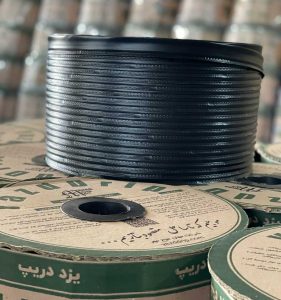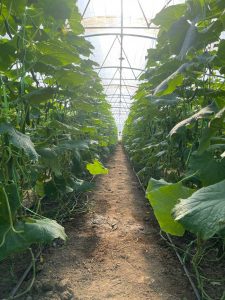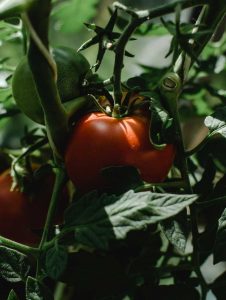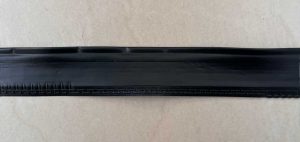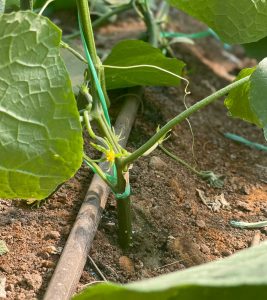Drip irrigation tape (drip tape)
Drip tape is a type of drip irrigation that was first produced about 50 years ago in the United States of America. This tape is made of polyethylene and unlike the hard polyethylene pipe, it is almost flat and very soft. In this training, we are going to discuss the benefits and applications of this type of irrigation.
Drip irrigation (Drip Tape) in Iran
Due to the fact that Iran is located in one of the dry regions of the world and its annual rainfall is low, and on the other hand, these rainfalls have an inappropriate temporal and spatial distribution, as well as the droughts that have occurred in our country in the last twenty years; farmers have no choice but to use the water they have. Because the level of the country’s underground aquifers decreases every year and causes a gradual decrease in Iran’s water resources.
Also, water loss during irrigation using surface or traditional irrigation methods is high, and the irrigation efficiency in common traditional methods is between 25-40%, therefore, we have to replace irrigation methods with new irrigation methods known as drip irrigation. Among the new methods, drip irrigation has more advantages than other irrigation methods, and drip irrigation is more suitable for use in fields with saline water sources than other common irrigation methods.
What is the Drip irrigation tape?
Drip tape is a type of drip irrigation that was first produced about 50 years ago in the United States of America. Drip irrigation tape is made of polyethylene and unlike hard polyethylene pipe, it is almost flat and very soft. Drapers on the brigade tape are also called plaques.
In fact, the Drip irrigation tape has a soft and flexible texture, which fills when water enters it, and the drops of water leave through the doors installed on the drip irrigation tape, and after the irrigation is finished, the tape is again flattened. The thickness of the tape wall is very thin and the distance between the drippers in the irrigation tape is different, and thicker tapes are usually used for subsurface irrigation of different plants.
Advantages of drip irrigation method (Drip Tape)
First, in the drip method, the irrigation interval is short and the root development area is always kept wet. Therefore, the soil solution from which the roots of the plant get the water and nutrients they need will remain diluted almost during the growth period of the plant and the concentration of salt will remain low.
Second, in drip irrigation, unlike methods such as rain, water is not sprayed directly on the plant, and chlorine and sodium ions in the water do not accumulate on the surface of the leaves, which cause them to burn.
Thirdly, in drip irrigation, the moistened volume of the soil, which is called the moisture bulb, is expanding to the outside of the plant, and the salt is regularly pushed out from the point of water drop from the dropper on the moisture front. And if the dropper is placed next to the plant or in a suitable place, the salt will be removed from the reach of the roots. In this publication, an attempt is made to provide tips for the use and maintenance of this system while familiarizing with strip drip irrigation.
Uses of Drip tape
Drip tape for drip irrigation of dense and row crops such as all kinds of vegetables, summer crops, row plants, fodder, etc., such as watermelon, tomato, onion, potato, corn, strawberry, sunflower, melon, sugar beet, cotton and corn are used. The drip irrigation tape can also be used in greenhouses.
Drip tape does not need a lot of water pressure and can be used in fields with low and high areas without the need for leveling the land. Also, the tip tape can be installed during cultivation and mechanized using a tractor.
Advantages of Drip tape
1) Quick and easy installation and convenient transportation of the tape. (Light weight)
2) Irrigation tape connections are available in the form of simple and standard parts, and its manual and machine operation method is very simple.
3) Special polymer material prevents algae and mineral deposits from sticking to it.
4) The resistance of the irrigation strip against ultraviolet rays of the sun, chemical fertilizers, pesticides and agricultural sprays.
5) Saving water consumption and increasing the cultivated area.
6) Reducing the cost of fertilizer.
7) Increasing crop yield and preventing the spread and growth of weeds on agricultural land.
8) The costs of secondary pipes in this method are lower than drip irrigation with a dripper.
9) A small space to maintain the irrigation tape is needed.
Due to the economical use of irrigation tapes, this method is used more in some crops, such as: corn from grains, potatoes and onions and tomatoes from the vegetables, melons and watermelons, and cucumbers from the fruits, cotton and sugar beet and sugar cane can be used for all crops from the family of industrial plants and also in greenhouses.
The specifications and features of Drip Irrigation Tapes available in Iran
The duration of using the irrigation strip is one agricultural season. A great variety in wall thickness, pipe diameter, dropper watering and outlet distances makes a wide range of this type of product available to designers and farmers. The tapes available in the Iranian market are made in Turkey, Korea, Italy and Iran, some of their specifications are listed below:
The most widely used drip irrigation tapes in terms of the distance between the drippers are the 20 and 30 cm strips, and the dripper distance is 10, 15, 25, 40, 50, 60, 80 and 100 cm. These tapes are made with water yield of 0.8, 1.3, 1.5, 1.6, 2, 2.5 and 3.8 liters per hour. The working pressure of the tapes is from 0.5 to 2 atmospheres depending on their hydration and thickness. Drip irrigation tapes are made with a thickness of 150, 175, 200 and 250 microns, and the most common thickness used is 175 microns or 0.175 mm.
Tapes are supplied in rolls of 1000, 1200, 1500 and 3000 meters. Also, due to the low thickness of the tapes, usually each roll of 1000 meters with a thickness of 174 microns weighs 11 to 12 kg. It should be noted that if there are organic substances in the irrigation water, it is necessary to use a disc filter or sand. The minimum required filtration is equivalent to 120 mesh.
1) When emptying the coils, avoid throwing or rolling them on the ground. Because by doing this, the packaging of the tape is damaged and contact with sharp objects will cause the irrigation tape to tear.
2) The coils of the drip irrigation tape should be arranged without opening the packaging, in a covered warehouse and away from work-producing and corrosive materials, on a platform with a height of 50 cm. Avoid keeping the irrigation strips in an open space and especially exposed to sunlight and rain. During the storage period, the tapes should be protected from rodents and insects, and unnecessary movement should be avoided.
3) Before installing the tape, the farm soil must be completely plowed and free of lumps and large pieces, while it is not recommended to plow and disc too much.
4) Installation of irrigation tapes is possible in two ways, manual and mechanized. In any case, under no circumstances should the tape be stretched on the ground or spread under force and tension. For this reason, the tape coil should be placed on a simple device whose axis is placed in two bearings on both sides and rotates easily, and installed by hand or mechanized. Avoid installing the reel on the side of the field and pulling the tape by the worker along the field, because this will cause scratches and reduce the life of the tape.
5) In case of mechanized tape installation, standard tape spreading systems must be used, so that along the entire path of the pipe, guiding the tape from the coil to the ground (including the entrance and exit of the tape from the pipe and the inner surface of the pipe) there should be no contact with sharp and abrasive surfaces that cause tearing and damage to the tape. Failure to pay attention to this issue can cause harmful losses for the consumer.
6) In order to prevent the tape from rotating during installation, it is better to make the inlet and outlet edges of the PVC pipe rectangular by heating.
7) Before installing the tape to the pipe, the main and semi-main lines of the minefields should be washed.
8) In areas where the speed of the wind causes the tape to move, the irrigation tapes should be fixed on the ground using plastic nails to fix the tape at appropriate distances.
9) If there is a possibility of snow and hail during the cultivation season. Avoid spreading the tape on the soil.
10) When using this system, it should be noted that if the moistened area of the soil is not wide enough, the plant will not establish well, and a strong wind or storm can uproot the plant. And the frequency of wind should also be considered because strong storms will have negative effects on plant growth.
Final conclusion
In the end, it should be mentioned that the main and key factor in the success of the drip irrigation method and having an economic justification and benefiting from its advantages is the correct design, taking into account the precise hydraulic basics, as well as the proper implementation and maintenance of the system.
There are many drip irrigation systems that have not been used successfully due to non-observance of design principles and have not earned the owner anything except wasted capital. Unfortunately, this lack of success is mostly attributed to the irrigation system itself, and as a result, its development and expansion have not been done to the extent that the current needs of the country require.

